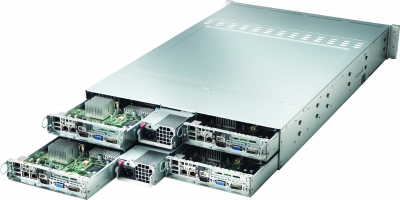Royal Baby, Schmoyal Baby – Pogo Has TWINS!

Twin servers, that is!
Good Things Come in Small Packages
What are twin servers? In a nutshell, twin servers give you the same computing power for less rackspace — with the added bonus of a lower initial capital cost and increased energy efficiency. By combining multiple compute nodes into a single chassis, you can free up 50% of your rack space without sacrificing processor performance or memory capacity. These twins may be tiny, but they are mighty. From big data and fast insights to web 2.0, mobile development, always-on connectivity, and hosted services, twin servers can do it all.

Deja Vu?
Now you may be thinking you’ve heard this story before, back when blade servers arrived on the scene. Twins carry some of the same advantages as blade servers but in a much simpler package with greater flexibility.
This makes twins a much better answer for general-purpose computing. Twins have their own exposed interfaces, so there are no backplanes to aggregate networking, KVM, etc. This flexibility and lack of failure points can make management and troubleshooting easier than a complete blade infrastructure.
Twin chassis typically support 2 or 4 nodes at a time, compared to 7-10 in a blade enclosure. These smaller numbers make it more cost-effective for customers to grow their infrastructure, and eliminates the need to buy an expensive blade chassis for only a few nodes. The nodes in twin servers are not as small as typical blade nodes, striking a good balance that allows for large memory footprints and high GHz processors, just like a full size server.
Power Savings – Form Meets Function
Each system node in a twin server has its own power supply — only the power plane in the chassis is shared. The twin server chassis is designed for optimized airflow, so you get optimum cooling and reduced power consumption. This helps keep cooling costs down, with a 47-degree Celsius ambient temperature max, even in the free-air-cooled environments of some data center configurations.
Show Me The Money: Rackmount Servers vs. Twin Servers
There are twin server options for almost any use case, including GPU and quad CPU. Some have up to eight system nodes, supporting some of the largest 3.5” HDDs available – even solid-state flash drives. IPMI allows complete remote management just like a regular rackmount server. The administrative benefits of managing more computing in less space and the ability to deliver twice the compute-density via parallel system nodes in one server are just a couple of twin servers’ many financial advantages.
We ran a cost analysis comparing one 2U Iris 2621 Twin Server with 4 nodes against four identically-configured 1U Iris 1261 rackmount servers. The hardware components included dual 6-core Intel Xeon e5 Series 2.0 CPUs, 32GB DDR3 memory (2x 16GB), and one 100GB SATA solid-state drives.

These two Pogo system configurations yielded the same computing output, based on the hardware (CPUs, memory, and hard drives). But thanks to its shared power and cooling components, the twin server came in at $1,405 less than the rack mount server. That’s an almost-12% cost-savings per node, without even factoring in the yearly electrical cost savings over the course of the product’s lifecycle.
So?
Soooo, if you’re an SMB with four or more servers, your organization is the ideal candidate to deploy a twin server, with the ability to scale-up your infrastructure down the road. Smaller businesses with growing IT needs may even save enough in energy costs by switching to twin servers to realize an immediate payback! (And considering the rising cost of electricity in some cities, the sooner an your IT department makes the switch, the sooner you would realize a return on your twin server investment!)

Familiarity with growing computing needs is essential to assessing whether a twin server strategy will adequately address forecasted computing needs, rising electricity costs, or space limitations. Pogo Linux offers two twin server models to meet your needs – the powerful Iris 1225 1U twin server with dual system-node capabilities, and the highly-dense Iris 2641 2U twin server with up to four system-nodes (as featured in our cost-analysis).
Not sure how much twin server provisioning you need? Give us a call at (888) 828-POGO), and we’ll help you “bring home” twins!
